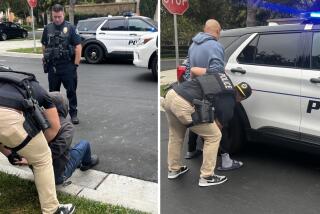Orange County prostitution fight puts new focus on shaming of johns
Mark Gagan, a police captain in Richmond, Calif., thought he’d found an effective crime deterrent this fall when he posted mug shots of the men arrested in prostitution stings on the Police Department’s Facebook page.
But what happened next shocked him. Although police listed the suspects’ names, Facebook users went onto the page to add their home addresses, workplaces, schools they attended and even graduation years.
“It went way beyond what I thought,” Gagan said, “and it gave me pause.”
Within 72 hours, he ordered the whole thing taken down.
Public shaming as a form of punishment goes back to the days of Puritan colonists. In recent years, it’s become a strategy for police departments targeting the sex trade.
In National City, Calif., authorities reportedly funneled the names of suspects to the local newspaper and, if the person was a teacher, a cop or in the military, notified employers. In Stockton, local cable networks showed photos of those convicted on a weekly “John TV” program.
But Orange County prosecutors are taking the tactic to another level: Asking every police agency in the county to hand over photographs of offenders so that they can be posted on the district attorney’s website under the heading “Sex Purchasers.”
The county’s largest city, Anaheim, home to Disneyland, has joined the effort and will publish the identities of those convicted.
In cities such as Fresno and Oakland, mug shots stay online for two weeks, but in Orange County, the mens’ faces will remain posted indefinitely.
The effort is aimed at curbing sex-trafficking by scaring away potential customers, said Susan Kang Schroeder, chief of staff for the district attorney.
“These men have to understand when they purchase a woman like she’s a commodity, they’re probably purchasing someone that has been trafficked,” Schroeder said. “They need to stop doing these things, and this is part of the consequences of the action.”
Orange County’s move is expected to heighten debate over whether public shaming is effective at reducing prostitution and whether it exposes johns to too much scrutiny.
Emma Andersson, staff attorney with the ACLU’s Criminal Law Reform Project, said in an email that the aim of the criminal justice system should be rehabilitation, rather than “the banishment and isolation of individuals from a community.”
Melissa Farley, executive director of the nonprofit Prostitution Research and Education, said she is unaware of any evidence that shaming has resulted in long-term behavior change. She thinks it makes more sense to increase criminal penalties on johns.
“In the long run, I think the law needs to change to reflect the seriousness of the crime as we now understand it,” Farley said, noting that Swedish law considers it the equivalent of a felony and has proved highly effective.
Prosecutors, however, argue that shaming brings a level of transparency to the secretive sex trade.
“All this crime that used to be behind closed doors, dark curtains, we’ve opened up and shed a light on it,” said San Bernardino County Dist. Atty. Mike Ramos, whose office started publishing photos of johns in April 2013. “We need to hold these people responsible, and here’s a way to do it. I truly believe it’s working.”
But defense attorney Lorrie Walton said that if her client had known his photo would be posted, he might not have accepted a plea bargain, which included three years of informal probation, 10 days in jail or Caltrans community service, and AIDS testing. Walton said she worries the website could be mistaken for a sex offender registry.
“The question is who knows about it and who’s looking at it,” Walton said. “Somebody that knows that guy ... very likely will share it, and it would be quite humiliating.”
Felix Garcia Arreola, 54, who was arrested this year for trying to hire a prostitute in Santa Ana, said he was humiliated but not necessarily upset, especially if the posted photos discourage others from doing what he did.
Still, he said no one told him his photo would be posted for all the Internet world to see.
“I’m embarrassed by what happened, and I regret it, and I can’t be too upset about this,” Arreola said in a phone interview. “I broke the law and was caught.”
Publicizing the identities of johns is not considered part of the punishment and would not be up for negotiation in a plea deal, Schroeder said. Asked if concern for solicitors’ personal lives factored into the decision to identify them, her response was unforgiving.
“Give me a break.”
The pursuit of johns as a way to combat commercial sex was adopted when attempts to punish prostitutes and pimps didn’t work, said Michael Shively, senior associate of Abt Associates, a private policy research firm.
Convicting pimps was nearly impossible because the key witness — the prostitute — was often too scared to testify against her pimp or had been exploited to the point of believing she needed him to survive, Shively said.
Going after prostitutes was not much better. For law enforcement, arresting the women felt like a game of “whack-a-mole,” Shively said, because they were bailed out of jail and sold sex elsewhere until they were caught again.
There has also been a shift among authorities in Orange County and elsewhere in viewing the prostitute as the victim, the pimp as the human trafficker and the customer as the enabler.
“It’s the johns that are creating that whole demand,” said Lt. Kevin Wiley, commander of the Oakland Police Department’s Special Victims section.
Although some agencies suspend driver’s licenses, impound cars, or mandate education programs, those convicted of prostitution-related crimes appear on websites nationwide.
San Bernardino County’s “Stop-the-John” Web page received 20,000 hits within the first week. Forty-two photos have been posted since, each staying online for a year.
On the Orange County district attorney’s website, the names of 185 convicted johns are listed — 74 of them with photos. Most of the suspects were picked up in areas that have long been known as havens for prostitution: Harbor Boulevard south of Disneyland and densely packed 1st Street in Santa Ana.
In the gallery of photos, most of the men have their hands cuffed behind them and their last names are scrawled on whiteboards held in front of their chest. Nobody is smiling.
When Gagan reflects on the brief experiment with social media in Richmond, he is still troubled by the consequences of the photos.
He believes the move was legal, and he believes the men were guilty. But he said the role of law enforcement is to investigate, not to hand down punishment.
“I’m re-thinking this as whether or not it’s the best way to handle this complex problem,” he said. “I’m not 100% convinced.”
Times staff writer Ruben Vives contributed to this report.
More to Read
Get the Latinx Files newsletter
Stories that capture the multitudes within the American Latinx community.
You may occasionally receive promotional content from the Los Angeles Times.






